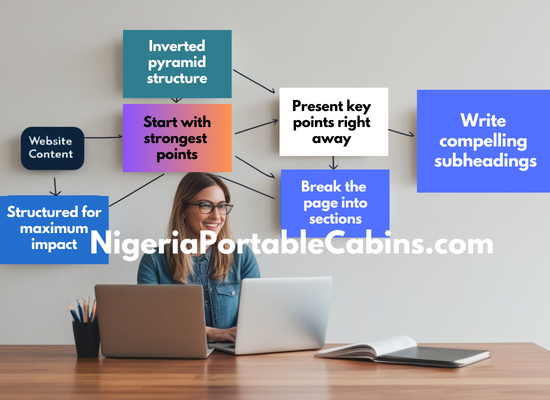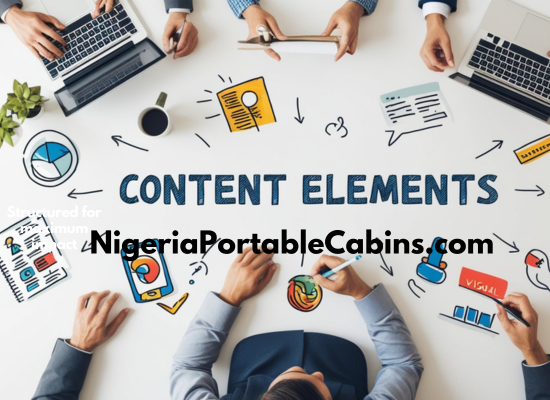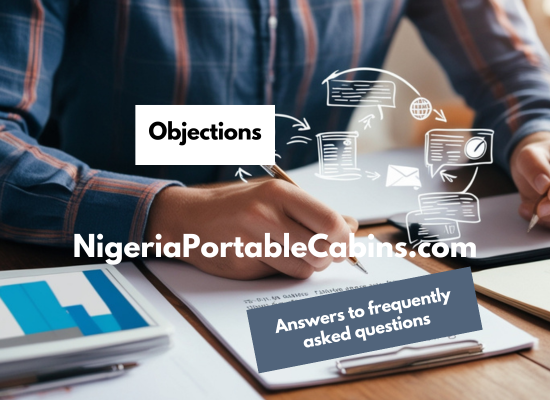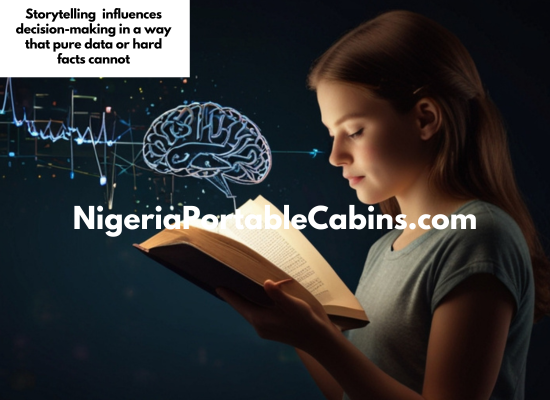Content Writing For A Website In Nigeria And Worldwide
Step-By-Step Guide On Writing Content For The Web
Content writing for a website in Nigeria and worldwide involves doing two things right.
The first thing you need to do is to write keyword-focused articles on your website or blog.
A keyword-focused article is an article that is centred on delivering content for a search phrase that online surfers normally type in search engines like Google when searching for information related to the niche in question.
The second thing you need to do right when writing content for the web is to write in easy-to-understand language. Write in an engaging and conversational style. And provide valuable information in your articles.
Yes, you want the articles in your website to be highly ranked in search engines like Google. So, you must write keyword-focused content when doing content writing for a website.
However, always remember that the content you write for your website will be read by real people with emotions and preferences.
Consequently, even if your website content is highly ranked by search engines like Google, and Google drives traffic to your website as a result, people who click on your article links on Google and land on your website will quickly close your website and head back to Google to find better written content if your web page content is not engaging and professional.
Bottom line.
Content writing for a website goes beyond search engine optimization techniques.
Writing content for the web is about establishing trust with your readers, and guiding them through a story that builds authority and credibility.
So, give your website visitors exactly what they’re looking for.
Write informative and valuable content that build relationships with website visitors. And that turn visitors into loyal customers.
Want to save time, avoid the learning curve, and publish your website content faster?
Click HERE to engage us to write content for your website.

The Basics Of Content Writing For A Website: Define Your Audience
Effective content writing for a website requires that you present your message in a way that aligns with the user’s needs while ensuring it’s optimized for search engine visibility.
Exceptional website content delivers real value that speaks to your audience’s challenges, desires, and emotions.
However, for your content to be effective, you must write for a specific audience.
You see, one of the frequently overlooked steps in content writing for a website is defining your audience before you begin to write.
Guess what.
Here’s where most online business owners make a fundamental mistake. And that is the mistake of attempting to appeal to everyone in their content.
The truth is this:
You waste your resources, and achieve poor results when your content speaks to everyone… and no one in particular.
To achieve online business success, your website content must speak directly to a specific group of people in a way that resonates with them.
Before you can write content that drives traffic, builds trust, and converts visitors, you must first know exactly who you're writing for. This is the foundational step that distinguishes mediocre content from content that delivers results.
So, how do you define the audience (or target market) you want your website content to serve?
First, draw up a list of the things or topics you’re passionate and knowledgeable about.
Second, use a keyword analysis software (or a keyword brainstorming software) to analyse each of those topics you’re passionate and knowledgeable about.
I use the SBI keyword analysis software, which is one of the software tools in Solo Build It! (SBI!), for analysing the niche topics (or sub-topics) I’m interested in building a website for.
A good keyword analysis tool will help you decide the niche that will be most profitable to build a website for. And the set of low competition keywords you should write articles for so you can attract traffic from search engines like Google to your website.
The next step is to evaluate the demographics you’re writing the content for.
The demographics of the target audience relates to things like the age, gender, location etc.
Another thing to research when considering writing content for the web is what is called the psychographics of your target audience, which include:
- The values of your target audience
- The motivations of your target audience
- The challenges or pain points of your target audience
- And the desires of your target audience
These insights allow you to craft content that truly speaks to their needs, concerns, and emotions. Thereby making your website content more compelling and impactful.
One more thing:
Defining your audience also means understanding their emotional triggers. That is, what keeps them up at night, what excites them, and what makes them take action.
Emotion is a powerful driver of behaviour, and content that taps into your audience’s emotional landscape can be far more effective than content that simply list facts or features.
For example, a SaaS company might recognise that its target audience isn’t just looking for software solutions; they’re looking for peace of mind, simplicity, and time savings.
By weaving these emotional appeals into the content, you create a stronger connection with your audience that goes beyond logic and taps into their deeper motivations.
Want to save time, avoid the learning curve, and publish your website content faster?
Click HERE to engage us to write content for your website.

Writing Content For The Web: Structuring Your Website Content For Maximum Impact
Writing content for the web that is effective also requires you to craft website content that is structured for maximum impact.
This involves guiding readers through a journey that enhances understanding, engagement, and conversion.
Structuring website content is about the flow of information.
Remember this: most website visitors do not read the entire material on a web page, especially in this era of short attention spans.
Most website visitors scan through web pages, jump from section to section, and focus on what grabs their attention. This is where the concept of the inverted pyramid comes into play.
The inverted pyramid structure is a concept that prioritises the most crucial information at the top of the web page, while supporting details follow below.
The idea is to present the key points right away, making it easier for users to find the information they need. This also increases the chances of keeping them engaged as they explore further details at their own pace.
Stating a web page with your strongest points establishes authority and relevance immediately, which is essential for both reader retention and for maintaining a high rank in search engines like Google.
Next, break the page into sections. And start each section with a boldly written sub-heading. The subheadings should all tie together and tell a mini-story, with each subheading leading naturally to the next.
Each section should stand alone as a mini-narrative that offers value, answers a question, or solves a problem. This approach ensures that even if a reader only skims through the web page, they can still extract key insights.
Subheadings should be compelling, and they should include keywords when relevant without feeling forced.
Using this technique not only makes your content more digestible but also allows search engines to better understand the structure and relevance of your article, improving search engine optimisation score, and attracting more visitors to your website from search engines like Google.
Here are some other techniques you can deploy to structure your content for better user experience and to maximum impact.
- Use bold fonts to emphasise key points
- Use bullet points for lists
- Use two or three sentences max per paragraph
- And use a lot of white space
These structural elements contribute to readability, making it easier for users to navigate through the web page.
Guess what.
Incorporating these elements on your web page means website visitors will spend more time on your website, which affects SEO metrics like dwell time (how long a visitor stays on your web page) and bounce rate (the percentage of visitors who leave without interacting further), both of which are signals that search engines use to determine the quality of your content.
Here’s one very important element you must not forget (or neglect). And that element is Call-to-Actions (CTAs).
When doing content writing for a website, ensure you incorporate calls-to-action (CTAs) in several places within the web page content.
If you don’t use this approach, you may end up converting fewer visitors into customers.
Here’s what a lot of people who offer content writing for a website do: they place their call-to-action at the end of the article.
The truth is this:
Most people who visit your website will not read the web page to the end.
People are busy. They are challenged by multiple unpleasant situations in life. And on top of that, most people today have short attention spans because of the presence of unlimited technology.
Consequently, most people who land on your website will not read all the information on the web page. They will not read to the end.
Therefore, if you want to convert more website visitors to paying customers, you must place call-to-action in several places in the article.
In fact, make it a practice to place a call-to-action link or button at the end of the first section of your article, which should be about 3 to 5 paragraphs long.
This will ensure that people who are ready to buy from you right away can quickly find the purchase button and click to purchase your product or service.
Please note:
Most of your CTAs should feel like a natural extension of the content.
For example, if you’re discussing real estate investing strategies, a CTA offering a downloadable checklist on “7 Pitfalls To Avoid When Buying A Property” could feel like a logical next step for the reader.
Another powerful method to improve content structure and impact is internal linking as part of the content structure.
Internal links help readers navigate through your website, directing them to related articles or deeper content that expands on the current topic.
For example, if a web page discusses a topic like “Real Estate Scams In Nigeria”, that page can link to another article (or another page) on the same website that discusses “Tips To Avoid Becoming A Victim of Nigeria Property Scams”.
Alternatively, the page about real estate scams in Nigeria can link to a service page that connect victims of Nigeria scams to a lawyer in Nigeria that has experience prosecuting scam cases in Nigeria.
Internal linking also enhances SEO by showing search engines how the pages of a website (and the content) are connected together, which helps to improve your site's overall authority.
Want to save time and publish your website content faster?
Click HERE to engage us to write content for your website.

Visual Elements In Website Content Writing
When people think of content writing for a website, most focus solely on the words.
That is understandable because content writing implies that the bulk of the work is in crafting engaging, informative text.
However, visual elements are a crucial aspect of content writing that can elevate the effectiveness of your message, engage readers on a deeper level, and even contribute to search engine optimisation success.
The strategic incorporation of visual elements can elevate your content, making it more memorable, persuasive, and effective at delivering your message.
According to the article "Incorporating Visual Elements In Your Content" from FasterCapital, content that includes relevant visuals see a 94% increase in views compared to text-only content.
This powerful statistic highlights the necessity of integrating visuals into your website content to boost engagement and conversion rates.
Bottom line.
Your website visitors will be better served when you take out time to think through the sort of images or videos you should add to your written content.
How should you use visual elements when writing content for the web?
We recommend integrating visual elements in multiple places within the web page that holds the written content to enhance clarity, build emotional connections, and guide the reader’s journey.
Here's the truth:
Visual elements improves comprehension and retention.
People are more likely to remember information when it’s paired with relevant imagery. So, use a lot of images when you do content writing for a website.
What kind of visual elements should you incorporate into your written content?
You can include:
- Images
- Charts
- Graphs
- And videos
It is okay to use stock images in your business website when necessary.
However, as a business, keep in mind that there are situations when custom visuals are likely to make a far stronger impact.
For example, custom illustrations, diagrams, or branded graphics allow you to tailor the imagery directly to the content, reinforcing your messaging and differentiating your brand.
Custom videos also play a huge role in improving engagement on your page.
In fact, videos offer a multi-sensory experience that text alone cannot provide, often leading to higher engagement and conversion rates.
So, integrate videos with your written content as much as possible.

Writing Content That Connects and Converts
Content writing for a website that connects with your audience and drives conversions is what every sane business owner seek.
That is the very reason why the research phase is very important.
There are two things that you must know about before embarking on content writing for a website.
You must know the keywords your target audience types into Google when they visit Google to look for solutions to their problems.
Second, you must understand the pain points of your target audience.
When you have thoroughly researched these two aspects, then you’re ready for the task of writing content for the web that speaks to those pain points, offers solutions, and converts website visitors to customers.
There’s one more thing to consider when doing content writing for a website.
Your website content must address objections associated with the niche of your business or the products and services you’re selling.
Most website content writers focus solely on the benefits of their products or services without addressing associated objections, which is the huge elephant in the room.
That is the very reason why most written content do not convert website visitors to customers.
Understand this fact:
Visitors to your website are not kids. Neither are they excited about throwing away their money or burning their cash.
Savvy audiences often have underlying doubts or concerns that prevent them from taking action.
They are adults who know what they want. And they want value for their money.
So, how do you effectively address potential objections and doubts head-on when writing content for the web?
Do the following:
- Provide data and explain in simple terms what that data means
- Display testimonials from customers who have actually used your product or service in the past or are currently using it.
- Use case studies
- Provide multiple online payment options so people can pay for your product or service immediately they come in contact with it on your website… and before they get distracted by something else
- Remove barriers to the sale (For example, reduce the number of times a potential customer has to click to place an order)
When content writing for a website address objections and doubts, the content connects emotionally with website visitors. And a higher percentage of website visitors become customers.
Want to save time, avoid the learning curve, and publish your website content faster?
Click HERE to engage us to write content for your website.

Engaging Storytelling In Website Content
The competition for website traffic has massively increased over the last couple of years.
Yes, more and more of your competitors are learning how to build websites and launching their websites virtually every week.
You may wonder:
“What aspect of content writing for a website can I explore to make my website stand out, resonate with my audience, and excite them enough to want to share my website with their friends and people in their network?”
The answer to that question is storytelling.
You see, weaving a compelling story into your website content writing help readers…
- Have better understanding of complex topics
- Connect emotionally with your brand
- And increase brand loyalty
People love stories, especially a captivating and entertaining story.
Want to increase brand loyalty and conversion rate?
Weave in entertaining stories when writing content for the web.
So, whether you’re explaining how a product solves a specific problem or sharing the journey of your brand, storytelling transforms dry, informational content into something engaging and entertaining.
When readers feel invested in the story, they are more likely to trust your brand, spend more time on your site, and take the desired action, whether that’s signing up for your newsletter, purchasing a product, or sharing your content with others.
Here are a few storytelling tips to keep in mind when considering weaving storytelling into content writing for a website.
- Use visuals and interactive elements. Don’t just talk, show what you’re talking about.
- Start with a Character
- Focus on conflict and resolution
- Use a conversational tone
Storytelling appeals to both the logical and emotional sides of the brain. That is why storytelling influences decision-making in a way that pure data or hard facts cannot.
A compelling story humanizes your brand, builds trust, and makes the reader feel understood.
This sense of connection makes website visitors more likely to engage with your content, share it, and ultimately convert into loyal customers.
Bottom line.
Effective content writing for a website leads to long-term success for the business.

Content Writing Services For Websites In Nigeria And Worldwide
We are a content writing company in Nigeria that offer content writing services for websites in Nigeria and worldwide.
We are based in Lagos Nigeria.
However, we offer website content writing services to customers in Nigeria and worldwide.
Want to save time, avoid the learning curve, and publish your website content faster?
Then engage us to write content for your website.
Order Website Content Writing
Fill the form below to sign up for our website content writing service.
NOTE: Please ensure the email address and phone numbers you enter in the form below are correct.
Having issues with submitting the form?
Call Samson Itoje on +2348033290430 or +2347086459367 to place your order.
Alternatively...
Click HERE to place your order via WhatsApp

